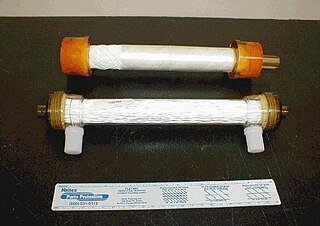Loading AI tools
Class of artificial membranes containing a semi-permeable hollow fiber barrier From Wikipedia, the free encyclopedia
Hollow fiber membranes (HFMs) are a class of artificial membranes containing a semi-permeable barrier in the form of a hollow fiber. Originally developed in the 1960s for reverse osmosis applications, hollow fiber membranes have since become prevalent in water treatment, desalination, cell culture, medicine, and tissue engineering.[1] Most commercial hollow fiber membranes are packed into cartridges which can be used for a variety of liquid and gaseous separations.





HFMs are commonly produced using artificial polymers. The specific production methods involved are heavily dependent on the type of polymer used as well as its molecular weight. HFM production, commonly referred to as "spinning", can be divided into four general types:
Common to each of these methods is the use of a spinneret, a device containing a needle through which solvent is extruded and an annulus through which a polymer solution is extruded. As the polymer is extruded through the annulus of the spinneret, it retains a hollow cylindrical shape. As the polymer exits the spinneret, it solidifies into a membrane through a process known as phase inversion. The properties of the membrane -such as average pore diameter and membrane thickness- can be finely tuned by changing the dimensions of the spinneret, temperature and composition of "dope" (polymer) and "bore" (solvent) solutions, length of air gap (for dry-jet wet spinning), temperature and composition of the coagulant, as well as the speed at which produced fiber is collected by a motorized spool. Extrusion of the polymer and solvent through the spinneret can be accomplished either through the use of gas-extrusion or a metered pump. Some of the polymers most commonly used for fabricating HFMs include cellulose acetate, polysulfone, polyethersulfone, and polyvinylidene fluoride.[5]
After fibers are created, they are typically assembled together in a membrane module, with many fibers in parallel. Fiber ends are fixed together in a resin or epoxy at both ends.[6] This part may be cut clean through to more readily expose their entrance/exits. Typically, these are place inside a cylinder, which has inlets and outlets on opposite sides for the bore (Lumen) side, and side ports for allowing flow to go over the membranes on the shell side. Typically, the higher pressure feed is on the bore side, to avoid fiber collapse.
The properties of HFMs can be characterized using the same techniques commonly used for other types of membranes. The primary properties of interest for HFMs are average pore diameter and pore distribution, measurable via a technique known as porosimetry, a feature of several laboratory instruments used for measuring pore size.[7] Pore diameter can also be measured via a technique known as evapoporometry, in which evaporation of 2-propanol through the pores of a membrane is related to pore-size via the Kelvin equation.[8][9] Depending on the diameters of pores in an HFM, scanning electron microscopy or transmission electron microscopy can be used to yield a qualitative perspective of pore size.

Hollow fiber membranes are ubiquitously used in industrial separations, especially the filtration of drinking water.[11]
Industrial water filters are mainly equipped with ultrafiltration hollow fiber membranes. Domestic water filtration systems have microfiltration hollow fiber membranes. In microfiltration a membrane pore diameter of 0.1 micrometers cuts-off microorganisms like germs and bacteria, Giardia cysts and other intestinal parasites, as well removing sediments. Ultrafiltration membranes are capable of removing not only bacteria, but also viruses.
Hollow fibers are commonly used substrates for specialized bioreactor systems, with the ability of some hollow fiber cartridges to culture billions of anchorage-dependent cells within a relatively low (<100 mL) bioreactor volume.[12]
Hollow fibers can be used for drug efficacy testing in cancer research, as an alternative to the traditional, but more expensive, xenograft model.[13]
Hollow fiber membranes are used in Membrane oxygenators in extracorporeal membrane oxygenation which oxygenates blood, replacing lungs in critically ill patients.

Seamless Wikipedia browsing. On steroids.
Every time you click a link to Wikipedia, Wiktionary or Wikiquote in your browser's search results, it will show the modern Wikiwand interface.
Wikiwand extension is a five stars, simple, with minimum permission required to keep your browsing private, safe and transparent.